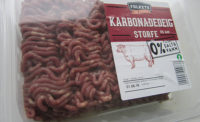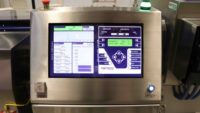Factory food waste is a serious and growing issue for manufacturers and one where choices about production equipment (including metal detection and other quality control) can have a surprisingly significant impact on outcomes.
North Americans waste an unfathomable amount of food. A study by the Environmental Protection Agency on the topic estimates that more food reaches landfills and incinerators than any other single material in everyday trash, about 21 percent of the waste stream. Although the estimates are widely different, some citing 60 million tons (or US $160 billion) worth of produce wasted annually, it’s clearly a controversial issue. Moreover, EPA’s food waste estimates do not include pre-consumer food generated during the manufacturing and packaging of food products[1], only food from consumer, institutional (i.e. hospitals, stadiums, and schools) and retail sources that ends up in the landfill.
While consumers hear messages about cutting food waste at home and retailers publicize their own efforts, losses from businesses supplying those retailers cannot be ignored.
According to the Food and Agriculture Organization of the United Nations, waste by consumers is between 209-253 lbs a year in North America. Some of this can be attributed to quality standards and consumer obsessions with the cosmetic appearance of fresh produce. Yet, approximately 60 percent of North America’s overall waste is said to occur at the production to retail phase[2]. Of this, some will be redistributed to food banks and other beneficiaries, some was recycled as animal feed, but a great deal continues to end up in landfill.
Who’s taking action?
It is indicative of the seriousness with which these losses are now viewed that reductions in food waste play a prime role in the U.S. 2030 Food Waste Loss and Reduction Goal, which aims to reduce food loss and waste by 50 percent over the next 15 years. The EPA's Food Recovery Challenge forms part of this program, with organizations pledging to improve their sustainable food management practices and report their results. In addition, globally recognized campaigns, including The Love Food Hate Waste initiative by the Waste and Resources Action Programme (WRAP) has been adopted outside the United Kingdom to Vancouver, Canada, for example. There are many more global grass root campaigns, 77 identified by PAC Food Waste, that are collectively pressing the food waste message home.
Environmental accountability and reporting are now facts of life for most food manufacturers as well as demonstrating corporate social responsibility (CSR), being able to reduce food waste in the first place has, like energy efficiency, a direct impact on any food manufacturer’s bottom line.
The mechanics of production waste reduction
Staff training and improved processes are helping to cut factory waste, with decisions about which equipment to buy and how to best control it also impacting the amount of false reject waste being generated.
In the case of food product inspection, specific features of likely contaminants, the product, packaging, processing and supply chain may determine whether metal detection is chosen for a particular point on the line. For example, if a processor needs to detect physical contaminants on free-falling products, they should use metal detectors rather than X-ray due to the inconsistent density within the falling product stream. For manufacturers constrained by limited line space, the larger size of x-ray units may also be a decisive factor.
Cost is another consideration. X-ray remains far more expensive, both in terms of capital cost and running costs. Expect to pay in the region of $50,000-$57,000 to install an entry-level x-ray machine, compared to between $5,500 and $25,000 for metal detection, depending on the size and complexity of the application.
In many cases, a food processor’s decision will depend on a very careful evaluation of the pros and cons of each technology. Some businesses may run away with the idea that x-ray is the more ‘modern’ technique, and should therefore be the default choice. In fact, arguments about metal detection versus x-ray are much more subtle. Any risk assessment needs to be approached from multiple perspectives. Food manufacturers should be wary of any advice implying that ‘you cannot put a price on food safety’.
Enough … and too much
Because the size, orientation and density of contaminants - among other variables - will affect detectability, metal detectors are inevitably set up and calibrated in order to err on the side of caution.
Food manufacturers will want to avoid excessive levels of false rejects, too. This is precisely where the competing demands of food safety and food waste overlap – and where the latest metal detection technology can help to cut waste while maintaining safety levels.
False rejections (which occur when perfectly good product is identified as containing a contaminant) are most common on lines handling ‘wet’ items. While this way of categorizing products does include literally wet or moist consistencies in anything from dairy, ready meals, dips, meat, poultry and fish and bakery; it also refers to any food matrix containing high levels of salt or other mineral fortification like chips and cereals. The common element is a strong ‘product effect’ (which registers relatively high conductivity and magnetic permeability) mimicking the signal picked up from metal, and so making any distinction between the two hard to establish. Traditionally, stainless steel has been especially difficult to detect in wet products since any signal can be effectively disguised by the product effect.
Fortress Technology’s most recent innovation in this area, the Interceptor metal detector, applies both high and low frequency ranges in order to isolate the product signal, and more readily identifies any contaminant signature beyond that. Trials with stainless steel in wet products have shown that Interceptor enables the pinpointing of contaminants as little as half the size of those detectable by the previous generation of equipment.
False rejects don’t just impact the physical waste where perfectly good food is discarded. Lower factory yield can undermine the cost-effectiveness of an entire operation, while repeated stoppages and trouble-shooting will incur unnecessary cost. Industry estimates put the cost per line of false rejects at over $14,000, depending on the scale of the problem.
Optimizing detection
Increasing the volume of inspection lanes for specific product ranges can also result in reduced food waste and enhance inspection productivity.
High-speed, multi-line food packing operations have a number of options when it comes to contaminant detection. Manufacturers can channel multiple lanes through a single, large metal detection aperture. The clear drawback here is that the larger aperture size sacrifices valuable levels of sensitivity. In addition, any reject system will remove an entire line of product across all of the lanes being checked, thus creating unnecessary waste.
There is the option of positioning a separate metal detector over each lane. This will mean product is only ever rejected from one lane, but the approach has major impacts in terms of cost and space efficiency. In today’s food factories, many of them working around legacy equipment and within severe spatial limitations, compact design is often a prime consideration.
The Fortress solution, already installed on multi-line operations checking sachets of herbs & spices and snack pots, is a single metal detection system with multiple apertures for each lane and a single operator panel. Each aperture is sized as closely as possible to the product. On the sachet line, Fortress recently became the first company to deliver a five-lane, ferrous-only multi-aperture detector.
The potential benefits are immense. On five conveyors, end-users can save up to 50 percent of the space required by individual metal detectors, around 17 percent of the installation cost, and up to 65 percent of the total cost of ownership, considering reduced maintenance and parts requirements.
Because this multi-lane metal detector has a dedicated aperture for each lane, the system is more sensitive to smaller metal particles and copes better with orientation and product effect. Best of all, each aperture operates like a standalone metal detector, inspecting and rejecting products on each line. So, in a twin lane configuration, false reject waste can instantly be halved.
A single control panel manages all lanes, which streamlines operator access and enables users to select and view production data by individual lane as well as analyse comparative lane data side-by-side. Because each lane can be programmed to run asynchronously from each other, if one lane goes down or requires maintenance, the remaining continue to run as normal. Which means production never has to grind to a halt.
These are just several of the more recent developments in metal detection that have a direct bearing on the amount of food waste manufacturers generate. It serves to demonstrate that food safety on the one hand and concerns about cost and wastage on the other do not necessarily pull the food industry in opposite directions. Technological improvements can help to contain costs, maximize space and reduce food waste.




Report Abusive Comment